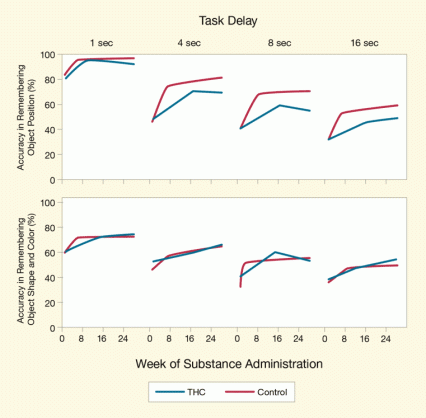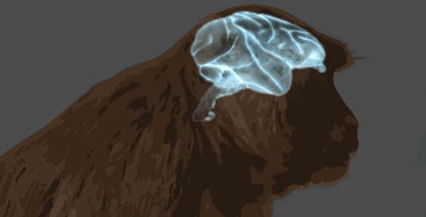A new study has added to evidence that exposure to Δ9-tetrahydrocannabinol (THC) may pose a particular threat to cognitive skills that are still developing in adolescence. Researchers reported that repeatedly exposing young rhesus monkeys to the main psychoactive ingredient in marijuana impeded the animals’ normal age-related improvement in spatial working memory.
Monkeys and people rely on spatial working memory for their moment-to-moment awareness of how the space around them is configured and how objects are distributed within it. In both species, spatial working memory normally improves from early adolescence to adulthood as the brain area whose activity endows it matures. In the recent study, adolescent monkeys that were exposed to THC fell progressively further behind THC-free monkeys in their ability to recall the location of an object after a brief delay.
A Drag on Development
Dr. David Lewis, Dr. Christopher Verrico, and colleagues at the University of Pittsburgh injected seven male adolescent rhesus monkeys with THC 5 days a week for 27 weeks. On each injection day, the monkeys received a dose of THC comparable to the amount a person might get from smoking a marijuana cigarette.
To assess THC’s persistent impact, the researchers tested the animals’ spatial working memory 1 to 3 days after each dose of the drug, when the drug’s acute effects had subsided. In the test, a monkey sat in front of a touch screen. A square flashed in one corner of the screen and disappeared. The screen remained blank for 1, 4, 8, or 16 seconds, and then squares appeared in all four corners. The monkey received a reward of water for touching the square in the corner where the original square had appeared.
At the start of the study, the THC-exposed monkeys performed as well on the test as a group of control monkeys that were given a non-active saline solution instead of THC. As weeks passed, both groups of animals got better at the test, but the THC-exposed monkeys improved less than the control animals, particularly after the longer delays (see Figure 1). In the test at 16 weeks, for example, the THC-exposed animals pointed to the correct square about 63 percent of the time after an 8-second blank-screen delay, and about 40 percent after a 16-second delay. The control animals’ comparable accuracy rates were about 71 percent and 59 percent.
 Figure 1. Regular THC Exposure Slows Improvement in Spatial Working Memory but Not in Object Working Memory Both THC- and vehicle-exposed (control) adolescent monkeys’ performance in a task measuring spatial working memory improved over the 27 weeks of the trial. However, THC-exposed monkeys’ spatial working memory improved less, particularly when they were challenged to remember the location of an object after longer delays (upper panel). THC exposure had no effect on the animals’ object working memory (lower panel). The monkeys’ memory skills were tested 1 to 3 days after the last THC exposure.
Figure 1. Regular THC Exposure Slows Improvement in Spatial Working Memory but Not in Object Working Memory Both THC- and vehicle-exposed (control) adolescent monkeys’ performance in a task measuring spatial working memory improved over the 27 weeks of the trial. However, THC-exposed monkeys’ spatial working memory improved less, particularly when they were challenged to remember the location of an object after longer delays (upper panel). THC exposure had no effect on the animals’ object working memory (lower panel). The monkeys’ memory skills were tested 1 to 3 days after the last THC exposure.
- Text Description of Graphic
-
The figure shows two line graphs horizontally arranged in four series, corresponding to task delays of 1, 4, 8, and 16 seconds. In the top chart, the y-axis indicates the accuracy in remembering an object’s position (as percentage of the total). In the bottom chart, the y-axis indicates the accuracy in remembering an object’s shape and color (as percentage of the total). The x-axis of both charts indicates the length of time the animals were given THC or saline (0, 8, 16, and 24 weeks). The top chart shows that all animals showed some initial improvement in accuracy in remembering an object’s position up to weeks 8 to 16 followed by no further improvement or a slight decline in monkeys exposed to THC (shown by blue lines). Overall, THC-exposed monkeys were less accurate in remembering an object’s position than control monkeys exposed to inactive saline (red lines); these differences were small for the 1-second delay (all animals showed about or above 80 percent accuracy, which improved to more than 90 percent accuracy within the first 8 weeks) and became larger for the 4-, 8-, and 16-second delays (for which the control monkeys showed about 80, 70, and 60 percent accuracy at the final measurements after 24 weeks, respectively, versus about 65, 55, and 50 percent, respectively, for the THC-exposed animals). The bottom chart shows that both the THC-exposed and control animals very similarly accurate in remembering the shape and color of an object; for each group, the accuracies were about 70, 60, 55, and 50 percent for the 1-, 4-, 8-, and 16-second delays, respectively.
A Selective Impact
Drs. Lewis and Verrico hypothesized that the young monkeys’ spatial working memory would be vulnerable to THC’s effects because the brain area whose activity supports it (the dorsolateral prefrontal cortex [dlPFC]) is still developing in adolescence. In rhesus monkeys, for example, the number of dlPFC neurons that are active during the spatial working memory task used in the study doubles from 12 to 36 months of age.
To test their hypothesis, the researchers compared THC’s impact on the monkeys’ spatial working memory with its effect on the animals’ object working memory. Object working memory, the faculty for recalling shapes after a brief delay, relies on a brain area (the ventrolateral PFC) that is already fully mature at the onset of adolescence.
The researchers assessed the monkeys’ object working memory in the same sessions in which they tested the animals’ spatial working memory, 1 to 3 days after each THC dose. The assessment method was analogous to that used to test spatial working memory, except that the animals had to touch the same colored shape they had previously seen on the screen, rather than the location where the shape was presented.
The comparison supported the researchers’ hypothesis. In contrast to its negative impact on the development of spatial working memory, THC did not affect object working memory. The THC-free control animals and the THC-exposed animals improved similarly in object working memory as they gained practice in doing the test.
The study findings suggest that THC impairs normal improvements in spatial working memory by delaying or blocking brain development in the dlPFC, Dr. Lewis says. The drug’s lack of an effect on object working memory rules out some alternative explanations for the THC-exposed animals’ downwardly diverging performance on the spatial working memory test, such as diminished general learning ability, motor, motivational, or attention processes.
“Brain functions that are actively maturing at the time of THC exposure may be particularly vulnerable to the adverse effects of the exposure,” Dr. Lewis concludes.
Digging Deeper
Dr. Lewis now wants to pinpoint the cellular and molecular processes that are affected by THC and are responsible for THC’s adverse effects on spatial working memory in the monkeys. Dr. Lewis plans to determine whether THC exposure was associated with alterations in the neurons that feature the cannabinoid receptor 1 (CB1) and in the other populations of neurons that are innervated by CB1-bearing neurons.
“Ultimately, we would like to see what impact repeated THC exposure might have on the molecular and anatomical properties of that circuit,” Dr. Lewis says.
“This is a very well-controlled study that clearly showed that there are persistent effects of THC on the ability to perform cognitive spatial tasks,” says Dr. Nancy Pilotte, chief of NIDA’s Functional Neuroscience Research Branch.
“Although a lot of studies show that marijuana impairs cognition in people, this study is probably the first step to figure out what aspects of cognition are most impaired by marijuana and to parse them out further,” adds Dr. Pilotte.
This study was supported by NIH grant DA023109.
Source:
Verrico, C.D.; Gu, H.; Peterson, M.L. et al. Repeated Δ9-tetrahydrocannabinol exposure in adolescent monkeys: persistent effects selective for spatial working memory. American Journal of Psychiatry 171(4):416-425, 2014. Full text

